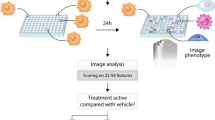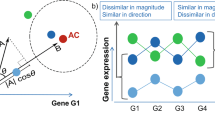Key Points
-
Scientific robustness refers to the ability of a finding to withstand experimental variation. Results that are reproducible, but only under an extremely narrow set of conditions, are unlikely to make predictions that will be true (robust) under real-world conditions, such as in the clinic.
-
Whether an elevated level of a particular protein is associated with a poor prognosis in a given cancer provides very little information as to whether that protein would be a good target in that cancer. Being associated with a poor prognosis is neither necessary nor sufficient to be a good cancer target.
-
The fact that A correlates with B and that it is biologically plausible that A causes B does not formally prove that A causes B. For example, observing that high expression of a gene correlates with poor survival in cancer patients and knowing that that gene regulates malignant cell behaviour would not formally prove that the high expression of that gene is responsible for the poor survival. Similarly, observing that a drug is having its expected pharmacodynamic effect on its intended target and knowing that its intended target is important for cancer cell survival would not formally prove that the cytotoxicity of the drug is on-target.
-
Most of the cellular assays used in cancer pharmacology are 'down' rather than 'up' assays, which is problematic because there are far more uninteresting ways to make a complex system, such as a cell, perform less well than there are to make it work better.
-
Cellular phenotypes caused by a chemical or genetic perturbant should be considered to be off-target until proved otherwise, especially when the phenotypes were detected in a down assay and therefore could reflect a nonspecific loss of cellular fitness. It is only by performing rescue experiments that one can formally address whether the effects of a perturbant are on-target.
-
The basis for the therapeutic indices of the currently available cancer drugs, including cytotoxic and targeted agents, is still poorly understood. Most successful drugs do not inhibit their targets completely and continuously at their therapeutically useful doses and accurately predicting, a priori, the therapeutic index for inhibition of a new cancer target is virtually impossible.
Abstract
An alarming number of papers from laboratories nominating new cancer drug targets contain findings that cannot be reproduced by others or are simply not robust enough to justify drug discovery efforts. This problem probably has many causes, including an underappreciation of the danger of being misled by off-target effects when using pharmacological or genetic perturbants in complex biological assays. This danger is particularly acute when, as is often the case in cancer pharmacology, the biological phenotype being measured is a 'down' readout (such as decreased proliferation, decreased viability or decreased tumour growth) that could simply reflect a nonspecific loss of cellular fitness. These problems are compounded by multiple hypothesis testing, such as when candidate targets emerge from high-throughput screens that interrogate multiple targets in parallel, and by a publication and promotion system that preferentially rewards positive findings. In this Perspective, I outline some of the common pitfalls in preclinical cancer target identification and some potential approaches to mitigate them.
This is a preview of subscription content, access via your institution
Access options
Access Nature and 54 other Nature Portfolio journals
Get Nature+, our best-value online-access subscription
$29.99 / 30 days
cancel any time
Subscribe to this journal
Receive 12 print issues and online access
$209.00 per year
only $17.42 per issue
Buy this article
- Purchase on Springer Link
- Instant access to full article PDF
Prices may be subject to local taxes which are calculated during checkout








Similar content being viewed by others
References
Prinz, F., Schlange, T. & Asadullah, K. Believe it or not: how much can we rely on published data on potential drug targets? Nat. Rev. Drug Discov. 10, 712 (2011).
Begley, C. G. & Ellis, L. M. Drug development: raise standards for preclinical cancer research. Nature 483, 531–533 (2012).
Frye, S. V. et al. Tackling reproducibility in academic preclinical drug discovery. Nat. Rev. Drug Discov. 14, 733–734 (2015).
Nosek, B. A. & Errington, T. M. Making sense of replications. eLife 6, e23383 (2017).
Errington, T. M. et al. An open investigation of the reproducibility of cancer biology research. eLife 3, e04333 (2014).
Flaherty, K. T. et al. Inhibition of mutated, activated BRAF in metastatic melanoma. N. Engl. J. Med. 363, 809–819 (2010).
Harris, C. C. p53 tumor suppressor gene: from the basis research laboratory to the clinic — an abridged historical perspective. Carcinogenesis 17, 1187–1198 (1996).
Semenza, G. L. Defining the role of hypoxia-inducible factor 1 in cancer biology and therapeutics. Oncogene 29, 625–634 (2010).
Mellor, H. R. & Harris, A. L. The role of the hypoxia-inducible BH3-only proteins BNIP3 and BNIP3L in cancer. Cancer Metastasis Rev. 26, 553–566 (2007).
Reiling, J. H. & Hafen, E. The hypoxia-induced paralogs Scylla and Charybdis inhibit growth by down-regulating S6K activity upstream of TSC in Drosophila. Genes Dev. 18, 2879–2892 (2004).
Brugarolas, J. et al. Regulation of mTOR function in response to hypoxia by REDD1 and the TSC1/TSC2 tumor suppressor complex. Genes Dev. 18, 2893–2904 (2004).
Keith, B., Johnson, R. S. & Simon, M. C. HIF1alpha and HIF2alpha: sibling rivalry in hypoxic tumour growth and progression. Nat. Rev. Cancer 12, 9–22 (2012).
Lin, A., Giuliano, C. J., Sayles, N. M. & Sheltzer, J. M. CRISPR/Cas9 mutagenesis invalidates a putative cancer dependency targeted in on-going clinical trials. eLife 6, e24179 (2017).
Gorre, M. et al. Clinical resistance to STI-571 cancer therapy caused by BCR–ABL gene mutation or amplification. Science 293, 876–880 (2001).
Azam, M., Latek, R. R. & Daley, G. Q. Mechanisms of autoinhibition and STI-571/imatinib resistance revealed by mutagenesis of BCR–ABL. Cell 112, 831–843 (2003).
Burgess, M. R., Skaggs, B. J., Shah, N. P., Lee, F. Y. & Sawyers, C. L. Comparative analysis of two clinically active BCR–ABL kinase inhibitors reveals the role of conformation-specific binding in resistance. Proc. Natl Acad. Sci. USA 102, 3395–3400 (2005).
Balbas, M. D. et al. Overcoming mutation-based resistance to antiandrogens with rational drug design. eLife 2, e00499 (2013).
Wacker, S. A., Houghtaling, B. R., Elemento, O. & Kapoor, T. M. Using transcriptome sequencing to identify mechanisms of drug action and resistance. Nat. Chem. Biol. 8, 235–237 (2012).
Kasap, C., Elemento, O. & Kapoor, T. M. DrugTargetSeqR: a genomics- and CRISPR–Cas9-based method to analyze drug targets. Nat. Chem. Biol. 10, 626–628 (2014).
Han, T. et al. The antitumor toxin CD437 is a direct inhibitor of DNA polymerase α. Nat. Chem. Biol. 12, 511–515 (2016).
Forment, J. V. et al. Genome-wide genetic screening with chemically mutagenized haploid embryonic stem cells. Nat. Chem. Biol. 13, 12–14 (2017).
Emery, C. M. et al. MEK1 mutations confer resistance to MEK and B-RAF inhibition. Proc. Natl Acad. Sci. USA 106, 20411–20416 (2009).
Nazarian, R. et al. Melanomas acquire resistance to B-RAF(V600E) inhibition by RTK or N-RAS upregulation. Nature 468, 973–977 (2010).
Losman, J. A. et al. (R)-2-hydroxyglutarate is sufficient to promote leukemogenesis and its effects are reversible. Science 339, 1621–1625 (2013).
Kaelin, W. G. Jr. Molecular biology. Use and abuse of RNAi to study mammalian gene function. Science 337, 421–422 (2012).
Kittler, R. et al. RNA interference rescue by bacterial artificial chromosome transgenesis in mammalian tissue culture cells. Proc. Natl Acad. Sci. USA 102, 2396–2401 (2005).
Brignole, C. et al. Immune cell-mediated antitumor activities of GD2-targeted liposomal c-myb antisense oligonucleotides containing CpG motifs. J. Natl Cancer Inst. 96, 1171–1180 (2004).
Munoz, D. M. et al. CRISPR screens provide a comprehensive assessment of cancer vulnerabilities but generate false-positive hits for highly amplified genomic regions. Cancer Discov. 6, 900–913 (2016).
Aguirre, A. J. et al. Genomic copy number dictates a gene-independent cell response to CRISPR/Cas9 targeting. Cancer Discov. 6, 914–929 (2016).
Blouw, B. et al. The hypoxic response of tumors is dependent on their microenvironment. Cancer Cell 4, 133–146 (2003).
Bridgeman, V. L. et al. Vessel co-option is common in human lung metastases and mediates resistance to anti-angiogenic therapy in preclinical lung metastasis models. J. Pathol. 241, 362–374 (2017).
Donnem, T. et al. Vessel co-option in primary human tumors and metastases: an obstacle to effective anti-angiogenic treatment? Cancer Med. 2, 427–436 (2013).
Tybulewicz, V. L., Crawford, C. E., Jackson, P. K., Bronson, R. T. & Mulligan, R. C. Neonatal lethality and lymphopenia in mice with a homozygous disruption of the c-abl proto-oncogene. Cell 65, 1153–1163 (1991).
Hamilton, A. L. et al. Proteasome inhibition with bortezomib (PS-341): a phase I study with pharmacodynamic end points using a day 1 and day 4 schedule in a 14-day cycle. J. Clin. Oncol. 23, 6107–6116 (2005).
Kaelin, W. J. Choosing anticancer drug targets in the postgenomic era. J. Clin. Invest. 104, 1503–1506 (1999).
Kaelin, W. G. Jr. The concept of synthetic lethality in the context of anticancer therapy. Nat. Rev. Cancer 5, 689–698 (2005).
Acknowledgements
The author thanks J. Losman, D. Nijhawan, W. Sellers and members of the Kaelin Laboratory for careful reading of this manuscript and useful suggestions. He dedicates this article to his late wife, Dr Carolyn M. Kaelin, who survived a breast cancer in 2003 but died of a glioblastoma in 2015.
Author information
Authors and Affiliations
Corresponding author
Ethics declarations
Competing interests
The author declares no competing financial interests.
Related links
Rights and permissions
About this article
Cite this article
Kaelin, W. Common pitfalls in preclinical cancer target validation. Nat Rev Cancer 17, 441–450 (2017). https://doi.org/10.1038/nrc.2017.32
Published:
Issue Date:
DOI: https://doi.org/10.1038/nrc.2017.32
This article is cited by
-
Identifying regulators of aberrant stem cell and differentiation activity in colorectal cancer using a dual endogenous reporter system
Nature Communications (2024)
-
Verification of nucleotide sequence reagent identities in original publications in high impact factor cancer research journals
Naunyn-Schmiedeberg's Archives of Pharmacology (2024)
-
Advances towards the use of gastrointestinal tumor patient-derived organoids as a therapeutic decision-making tool
Biological Research (2023)
-
Target-dependent RNA polymerase as universal platform for gene expression control in response to intracellular molecules
Nature Communications (2023)
-
Hypoxic microenvironment in cancer: molecular mechanisms and therapeutic interventions
Signal Transduction and Targeted Therapy (2023)



